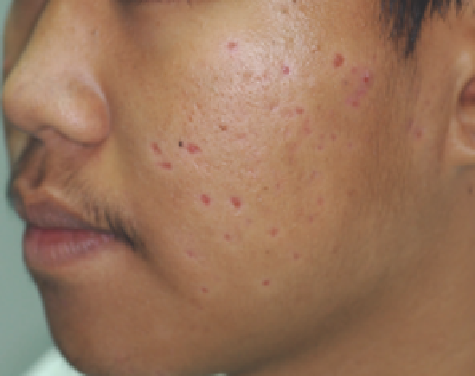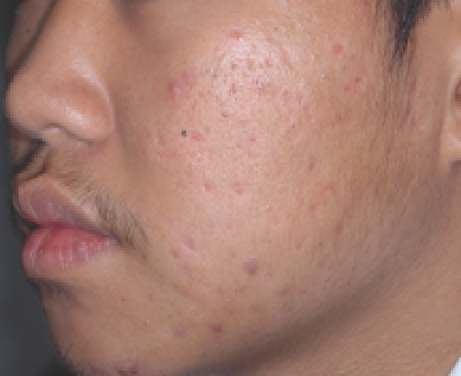Biomedical Engineering Reference
In-Depth Information
(
A
)
(
B
)
Figure 13.19
(
A
) A 19-year-old man (skin phototype V) with moderate to severe atrophic acne scars at baseline. (
B
) Clinical appearance 4 months after two
variable square pulse erbium:yttrium-aluminum-garnet laser treatments.
Source
: From Ref. 183.
Infl ammation in the postoperative period is a normal cas-
cade of the healing process, but prolonged infl ammation is
not. Clinically, persistent postoperative erythema is a strong
predictor of delayed-onset hyperpigmentation. Consequently,
infl ammation in darker-skinned individuals leads to hyper-
pigmentation and, if long-standing, may cause permanent
depigmentation. All factors producing tissue infl ammation
during the healing process should be minimized or eliminated
in these patients to reduce the risk of pigmentary alterations.
Mechanical trauma (excessive rubbing of the tissue between
laser passes), irritants, chemical causing an allergic contact
dermatitis, and prolonging infl ammation from an opportu-
nistic infection should be prevented. Use of topical corticoste-
roid ointment from days 3-7 at night will help decrease
infl ammation. We recommend using an ointment that does
not contain any stabilizing agents. We use fl uocinolone oint-
ment in petrolatum.
In brief, ASR is effective in treating photodamaged skin and
acne scars in Asian patients with skin phototypes III-V. How-
ever, it must be performed with great caution, together with
proper preoperative and postoperative treatment regimens,
and sun avoidance. A test patch may be used when considering
skin resurfacing for this group of patients. However, this is not
always a reliable predictor of postoperative complications.
Another application which the CO
2
laser offers defi nite advan-
tage is in vaporization of selected epidermal and dermal
lesions.
In the current practice, we successfully use the CO
2
laser to
remove epidermal growth, such as seborrheic keratosis or ver-
ruca vulgaris, and benign nevomelanocytic nevi with low risk
of adverse complications. The defi nite advantages of the CO
2
laser for removal of these lesions are the extreme precision in
depth of ablation, leaving minimal damage to adjacent normal
tissue, the speed of the treatment of multiple lesions, and near-
bloodless fi eld.
Clinical use of the CO
2
laser for this application must be
guided by close attention to laser-tissue interaction during the
procedure. The lesion is vaporized layer by layer by moving a
defocused beam of the CW CO
2
laser with a spot size of 3 mm
at 3-5 W across the surface of the lesion at a speed of approxi-
mately 1 cm/s. With thick lesion, several passes over the same
area are necessary. A cotton-tipped applicator soaked in saline
solution is used to remove vaporized debris after each pass.
The endpoint of treatment is when the lesion is removed or a
chamois yellow appearance is seen (Fig. 13.20). Treatment can
be repeated at 4- to 6-week intervals if the lesion recurs.
When laser is used to remove nevomelanocytic nevi, several
concerns should be judged. First, for Asians, the use of this tech-
nique should be avoided if there is any other risk of melanoma,
including previous history or family history of melanoma, and
clinical evidence of atypia. Second, for Caucasians, such use
should be considered as the last resort of treatment. Third,
recurrence of the treated nevus may show histologically atypi-
cal cells, termed pseudomelanoma (192).
nonablative laser systems
Despite the favorable results seen with CO
2
and Er:YAG laser
resurfacing, the enthusiasm for these systems has been limited
by the prolonged recovery time, long-lasting erythema, and
dyspigmentation (hypo- and hyperpigmentation). To over-
come the problems associated with ASR procedures, so-called
nonablative dermal remodeling (NDR) techniques have been
developed (193-196). The NDR technique involves the use of
a cooling device to protect the epidermis, and in doing so
allows high-energy laser light in the infrared spectrum to be
delivered to the dermis. NDR induces the formation of new
dermal collagen by creating a dermal wound without disrup-
tion to the epidermis and repair of tissue defects related to
photoaging.
Although NDR lasers are not yet capable of results compa-
rable with those of ablative laser systems, they have been shown
to improve mild to moderate atrophic scars, rhytides, pigmen-
tation, and telangiectasia. These NDR devices may be particu-
larly suited to Asian patients because photoaging in Asians
tends to have fewer wrinkles but higher pigmentary disorders
(7). Furthermore, the adverse effects that are associated with
ablative laser resurfacing systems, such as erythema and PIH,
are particularly common and problematic in Asian skin.

















